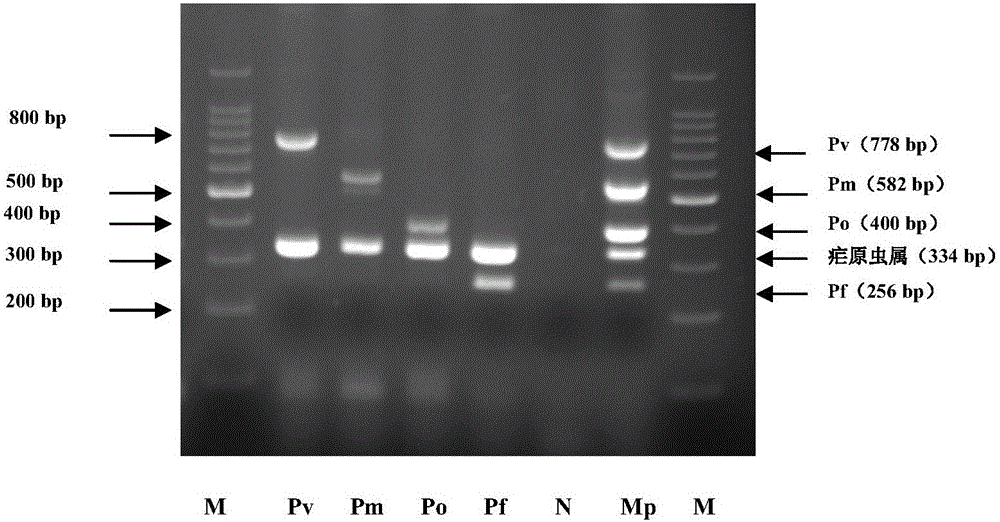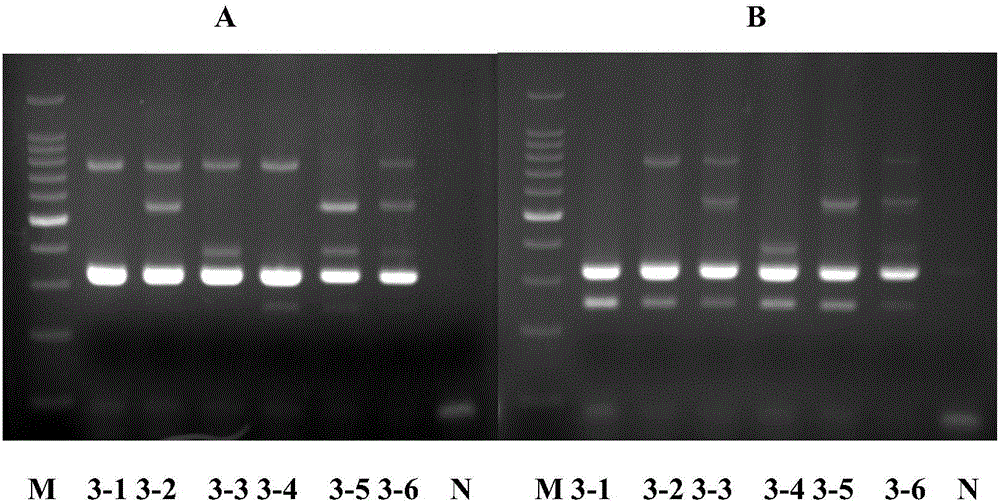Chimeric primer multiple PCR molecular detection kit for malaria species-genera detection and detection method thereof
A technology of chimeric primers and molecular detection, which is applied in biochemical equipment and methods, measurement/testing of microorganisms, resistance to vector-borne diseases, etc. Specific identification and other issues, to achieve the effect of improving detection sensitivity and specificity, clean background, and less non-specific amplification
- Summary
- Abstract
- Description
- Claims
- Application Information
AI Technical Summary
Problems solved by technology
Method used
Image
Examples
Embodiment 1
[0071] Embodiment 1, chimeric primer multiple PCR detection system and method for the same detection of malaria species
[0072] 1.1 Design of chimeric primers
[0073] The ribosomal 18SrRNA and mitochondrial genes of Plasmodium were selected as target sequences. A total of five pairs of Plasmodium and species-specific primers were designed using GenBank public database resources (http: / / blast.ncbi.nlm.nih.gov / Blast.) and primer design software PrimerPrimer5.0 (Table 1). Among them, the amplified product of Plasmodium-specific primers is a conserved segment of mitochondrial genes, and the specific primers of four human Plasmodium species amplify ribosomal 18SrRNA-specific segments respectively. The gene-specific primers in Table 1 were respectively connected to a common non-specific nucleic acid fragment (universal primer, 5'-CGAGTCCTGCGGTCTCAAATT-3'). The 3' end of each primer is a sequence-specific recognition site, and the 5' end is a 21bp unrelated sequence to form a chi...
Embodiment 2
[0084] Example 2, Sensitivity and specificity analysis of chimeric primer multiplex PCR detection system for the same detection of malaria species
[0085] 2.1 Counting of protozoa
[0086] Whole blood samples were coated with thick and thin blood films, dried, fixed in methanol, and then stained with Giemsa. Plasmodium was checked and counted by experienced microscope examiners. The method of counting malaria parasites is to count more than 200 white blood cells, and count 1000 white blood cells when the density is very low. The density of malaria parasites was calculated by the following formula: number of malaria parasites ÷ number of white blood cells × number of white blood cells per μL of blood = number of malaria parasites / μL of blood (if white blood cell counts cannot be counted, calculate as 8000 white blood cells / μL of blood).
[0087] 2.2 Sensitivity of multiplex PCR detection of blood samples with different protozoa densities
[0088] Select 3 copies of each of t...
Embodiment 3
[0096] Embodiment 3, multiplex PCR detection malaria patient and normal person's blood sample
[0097] The detection effect of single-blind method on 20 blood samples of malaria patients (8 samples of P. Figure 5 shown. Except for 2 samples of malaria malaria with slight miscellaneous bands, the bands of other malaria samples were clear and the background was clean. There was no obvious cross-reaction in normal blood samples. In the multiplex PCR detection system, different "band types" formed by the combination of genus-specific bands and species-specific bands make the results clear at a glance and easy to judge.
[0098] The chimeric primer multiple PCR molecular detection kit and its detection method of the same detection of malaria species in the invention are adopted, and its technical effect is:
[0099] 1) Four species of human Plasmodium can be determined in one reaction. For a single Plasmodium infection sample, two specific gene fragments of the genus and speci...
PUM
 Login to View More
Login to View More Abstract
Description
Claims
Application Information
 Login to View More
Login to View More - R&D
- Intellectual Property
- Life Sciences
- Materials
- Tech Scout
- Unparalleled Data Quality
- Higher Quality Content
- 60% Fewer Hallucinations
Browse by: Latest US Patents, China's latest patents, Technical Efficacy Thesaurus, Application Domain, Technology Topic, Popular Technical Reports.
© 2025 PatSnap. All rights reserved.Legal|Privacy policy|Modern Slavery Act Transparency Statement|Sitemap|About US| Contact US: help@patsnap.com



